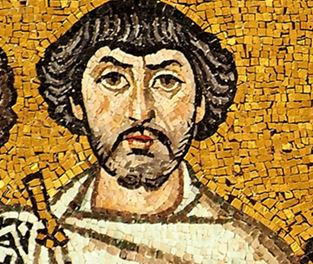
Battle of Thannourios(Battle of Minduos) |
year: 528 |
| The Persians attacked to prevent the building of a new fortress with losses for both sides | ★ ★ ★ ★ ★ |
|
enemy: Sassanid Persians
|
location: Ancient city Thannurios, present-day Tell Tunainir in NE Syria
|
accuracy:
●●●●●
|
|
battle type: Pitched battle |
war: Iberian War (526-532) |
modern country:
Syria |
| ▼ The Byzantines(emperor: Justinian I) | ▼ The Enemies | |
| Commander: | Belisarius, Coutzes | General Xerxes |
| Forces: | outnumbered | 30,000 |
| Losses: | Heavy | 500 Immortals an+d others |
| Background story: |
| After the death of Emperor Justin in 527, his nephew Justinian ascended the throne and continued the war against the Sassanid Persians. The war had begun shortly before Justin's death, because of the efforts by the Persian Shah Kavadh Ι to forcibly convert the Georgians (Iberians) to Zoroastrianism. This is how the “Iberian War” started. In 527, a Roman army led by Generals Sitta and Belisarius invaded Persarmenia, where it was defeated and repulsed after some initial successes. This was the first military action in which the participation in a leading role of the later brilliant general Belisarius is mentioned. At that time, he already had at his disposal the Voucellarii, the elite unit of heavy cavalry that he himself had trained and which was the core in all his campaigns from there on. The following year, in 528, Justinian ordered Belisarius to build a new fort on the border with the Persians, near Daras. The site chosen for the new fortress was near the village of Mindouos, in the ancient city of Thannourios, present-day Tell Tunainir in northeastern Syria. The point was of strategic importance (Procopius points this out), on the river Avorra (today “Khabur”), one of the major tributaries of the Euphrates. Belisarius took over the project with his usual efficiency and the construction proceeded quickly. The Persians, of course, became alarmed at the prospect of a new fortress on their frontier and tried to prevent its construction in various ways. When Justinian was informed of the reactions of the Persians, he ordered an army from Lebanon to rush to the area, led by Generals Cutzes and Vutzes. Aid also came from the Gassanid Arabs led by their ruler, Gavalas (Jabala ibn al-Harith). |
The Battle: |
 Belisarius It seems that initially the goal of the Persian army was just to intimidate the Romans and to make them leave the area and cancel the building of the castle. It is not clear how and why the hostilities escalated. Maybe, if the Byzantines had not received reinforcements, they would have left without further problems. Another thing that is not clear is whether one or two battles took place, one in Thannourios and another in Mindouos, very close to each other time-wise and space-wise (so, in any case, it was really one battle). What is certain is that a fierce battle took place. At one point the Persians tricked the Roman infantry to pursue them and led them to a spot where they had dug trenches in the ground, where the Romans were trapped. Belisarius counterattacked with his cavalry, but could not achieve much, as the Romans were outnumbered. So he was forced to retreat and since he could not defend the unfinished fortress at Thannourios, he left with the Byzantine army and headed for Daras, 90 km further north. The losses of the Byzantines were severe. Gavalas fell from his horse and was killed. Cutzes was taken prisoner and nothing was heard about him again. In addition, there were casualties from thirst on the difficult route to Daras, as the army was unprepared to move into the desert of northern Syria and had no supplies or water. The Persians captured the fortress at Thannurios and tore down the walls. Then they returned to their country. But they also suffered significant losses and it’s impressive that 500 of the Immortals, the elite body of the imperial guard, were killed, something that enraged King Kavadh. |
Noteworthy: |
| In Procopius’ De Aedificiis , which describes castles and cities of the empire, it is mentioned (regardless of the present battle) that in Thannourios there are two fortresses, a small and a large one. In fact, he makes a special mention of the “huge, made of hard stone” tower of Thannurios, manned with a strong guard. So, it seems that some time later, during the reign of Justinian, the Byzantines were finally able to build the fortress. |
Aftermath: |
| This battle took on unexpectedly large proportions with significant losses on both sides and may have been the reason for the further escalation of the war. General Xerxes, although formally a winner, was ousted due to the losses. Belisarius was soon appointed general of the East (Magister Militum per Orientem). He was obviously not held responsible for the defeat and that is why it is speculated that he probably did not have the command in this particular battle. |
|
|
